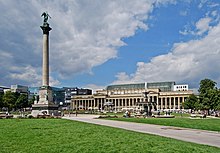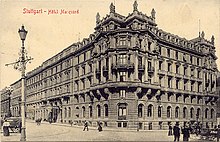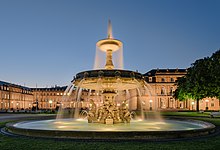Schloßplatz (Stuttgart)




The Schloßplatz in Stuttgart is the largest square in the center of Stuttgart .
location
The square divides the approx. 1.2 km long main pedestrian zone of Stuttgart, the Königstrasse into the lower Königstrasse towards the main station and the upper Koenigstrasse towards Rotebühlplatz .
The planie runs at right angles to Königstrasse on the southern side of the square . This traffic-calmed street in the area of the Schloßplatz connects the Schloßplatz past the adjoining Karlsplatz with the Charlottenplatz , where it joins the main roads running there. It should be noted that many of the straight street axes in the city center have no precise orientation with the cardinal points; this also applies to the facades of the New Palace and the sides of the square. The Königstraße leads from its upper end in the south approximately in a north-northeast direction to the main station.
Development
The palace square consists of a baroque garden with a fountain and music pavilion. In the center there is a 30-meter-high anniversary column with a figure of the goddess Concordia from 1841. The square was redesigned in 1977 on the occasion of the Federal Garden Show and has remained in this form to this day.
To the east, the New Palace with its courtyard forms the end of the square. As an extension of the New Palace, separated by a traffic axis, the Old Palace joins on the south side - in the west the Old Chancellery with the Mercury Column , which was built in 1598 as a water tower for the fountain works in the Lustgarten. The gilded youth figure is from 1862.
On the north side of the New Palace, the exhibition building of the Württembergischer Kunstverein joins at right angles . Next to it is the Queen Olga Building , in which the Stuttgart headquarters of the Dresdner Bank was for many years .
At the northwest corner is the Marquardtbau, which previously served as a hotel and next to which Stuttgart's first main train station was located until 1922. The building was rebuilt in a simplified form after the war. It opens, so to speak, the continuation of the Königsstrasse to the east. Today you can find the comedy in the Marquardt and a cinema there. At this corner of the square there is a statue of Duke Christoph .
Directly opposite the New Palace, the square is limited to the west along Königstrasse by the Königsbau . The two buildings are the most distinctive on the square and contribute significantly to its appearance. The late Classicist Königsbau was built between 1855 and 1859 by the court architects Johann Michael Knapp and Christian Leins . Directly behind it - seen from the square - the ten-story Königsbau-Passagen shopping center opened in April 2006 with 25,000 m 2 of retail space.
The Stuttgart Art Museum , which opened in 2005, is located next to the Königsbau . The Kronprinzenpalais, which was badly damaged in an air raid in World War II, was located here . This was only demolished many years later in favor of road traffic, when many buildings had already been rebuilt elsewhere.
As a follow-up to the Kronprinzenpalais , the Kleiner Schloßplatz - which has been controversial since its opening in 1969 - and the neighboring building of the Wittwer bookshop were built . The traffic initially only drove into an underground structure in the Königstrasse area, on the Kleiner Schloßplatz there were pavilions (boutiques, advance ticket sales) and at the end of the (Baden-) Württembergische Bank building (architect: Rolf Gutbrod ). After a renovation, the B-27 tunnel now begins higher up on Planie (straße).
In the 1990s, a large flight of stairs was installed in front of the former tunnel mouth , connecting the higher-lying Kleiner Schloßplatz with Königstraße and the actual Schlossplatz. In March 2005, the new art museum in the form of a partially transparent glass cube was placed on the Kleiner Schloßplatz, which was laterally supplemented by a reduced form of the open staircase, which is very popular with the Stuttgart residents, especially in summer.
Transport links
- Streets: The Schloßplatz is in the area of the Bundesstrasse 27 , which crosses under the Kleiner Schloßplatz and then leads in the direction of Ludwigsburg / Heilbronn. In the opposite direction, the B 27 leaves its tunnel after Schloßplatz at the level of the New Palace and Karlsplatz and continues over the intersection with the Bundesstraße 14 towards Tübingen.
- Public transport: Bus lines 42 and 44 and all 17 night bus lines run to and from Schloßplatz. The U5, U6, U7, U12 and U15 light rail lines stop at an underground station. The Charlottenplatz and Friedrichsbau stops are about a four-minute walk away.
Events
Various major events such as open-air concerts, live broadcasts or the Stuttgart children's and youth festival, which is well known in southern Germany, take place on Schloßplatz throughout the year. Every year at the end of April / beginning of May, the open air film presentations of the Stuttgart International Animated Film Festival take place here.
literature
- Uwe Bogen (text); Thomas Wagner (photos): Stuttgart. A city changes its face. Erfurt 2012, pages 50–51.
- The Schlossplatz . In: Eugen Dolmetsch: From Stuttgart's Past Days (second volume of "Pictures from Old Stuttgart"). Self-experienced and retold. Stuttgart 1931, pages 70-79.
Web links
- Palace Square City Panorama - Interactive 360 ° Panorama
Individual evidence
- ↑ historical name, hence the official spelling
Coordinates: 48 ° 46 ′ 42.8 " N , 9 ° 10 ′ 47.7" E

